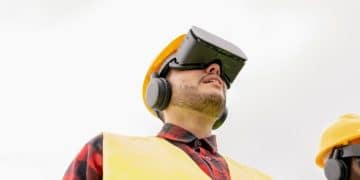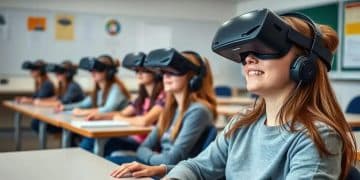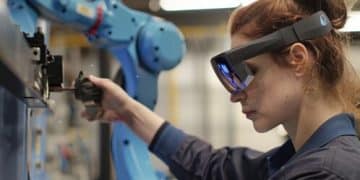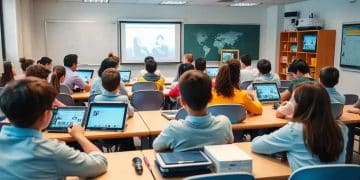Virtual lab simulations trends shaping the future
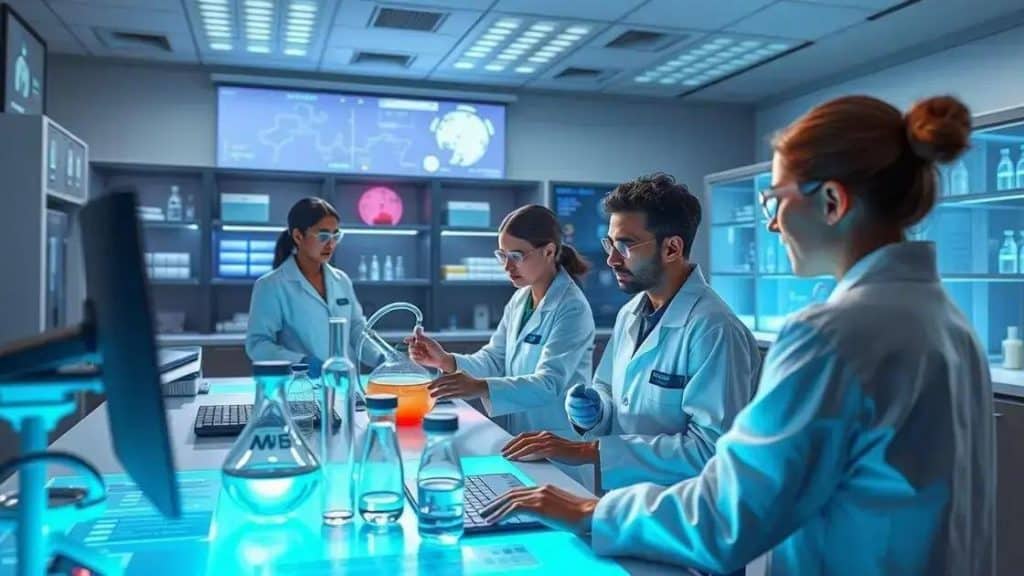
Virtual lab simulations use technology to provide immersive and interactive learning experiences, enhancing safety, engagement, and collaboration while allowing students to explore complex scientific concepts in a customizable environment.
When we talk about virtual lab simulations trends, it’s crucial to recognize how they change the landscape of education and research. Have you ever wondered how these simulations enhance hands-on learning?
Understanding virtual lab simulations
Understanding virtual lab simulations is crucial in today’s educational landscape. These simulations provide students with invaluable hands-on experience, allowing them to explore complex concepts without the risks associated with physical labs.
In a virtual lab, students can perform experiments in a safe environment. They can manipulate variables and observe outcomes in real-time, fostering a deeper understanding of the material. This approach is especially beneficial in fields like chemistry and biology, where practical experience is essential.
The Features of Virtual Lab Simulations
One of the exciting aspects of virtual lab simulations is their interactive nature. Students can engage in vibrant learning experiences that traditional classrooms often lack. These labs are designed to simulate real-life scenarios, helping students grasp challenging concepts more effectively.
- Access to a variety of experiments.
- Immediate feedback on their actions.
- Flexibility to learn at their own pace.
- Realistic visualizations of scientific principles.
Furthermore, virtual labs often incorporate multimedia elements, making learning more engaging. For instance, animations can clarify processes like chemical reactions or ecological interactions. Students benefit from a multi-sensory approach, which is proven to enhance retention and understanding.
Impact on Education
The impact of virtual lab simulations on education is profound. They bridge the gap between theory and practice, allowing students to apply what they’ve learned in realistic settings. This application of knowledge is critical for developing the skills necessary for future careers in science and technology.
Another significant advantage is that these simulations can be tailored for different learning styles. Whether a student learns best through visual, auditory, or kinesthetic methods, virtual labs accommodate all preferences. This inclusivity is vital in ensuring that every student has the opportunity to succeed.
The impact of technology on virtual labs

The impact of technology on virtual labs has been transformative and continues to grow every day. With advancements in digital tools and software, learning experiences are becoming more interactive and engaging.
One major benefit of technology is the ability for students to conduct experiments in a fully virtual environment. This eliminates many logistical issues that come with traditional labs, such as safety hazards and the need for physical materials. Students can explore various scientific concepts without the limitations seen in real-world labs.
Enhanced Learning Experiences
Virtual labs use technology to create immersive simulations that resemble real-life scenarios. These experiences help students grasp complex topics by providing them with hands-on learning opportunities. With various multimedia elements, students can watch simulations of chemical reactions, biological processes, and more.
- Interactive elements to engage students.
- Instant feedback to guide learning.
- Access to a wide range of experiments.
- Ability to repeat experiments to strengthen understanding.
Moreover, technology allows for greater collaboration among students. Many virtual lab platforms enable group projects where learners can work together from different locations. They can share their findings, discuss results, and learn from one another in a dynamic way.
Accessibility and Flexibility
Another profound impact of technology on virtual labs is the increased accessibility they offer. Students can access virtual labs from anywhere, at any time. This flexibility makes education more personalized, allowing learners to engage with the material when it suits them best. It also benefits schools with limited resources, providing students with access to high-quality educational tools.
As technology continues to evolve, we can expect virtual labs to become even more advanced. Innovations in artificial intelligence and augmented reality could further enhance these educational platforms, offering students even richer and more compelling learning experiences.
Benefits of using virtual lab simulations
The benefits of using virtual lab simulations are numerous and impactful. These simulations offer a unique way for students to engage with complex scientific concepts without the challenges posed by traditional labs.
One of the primary advantages is enhanced safety. Virtual labs allow students to conduct experiments that may involve hazardous materials or reactions without any real-world risks. This safe environment encourages exploration and experimentation, which can lead to a deeper understanding of scientific principles.
Cost-Effectiveness
Another significant benefit is cost-effectiveness. Creating a physical lab can be expensive due to the need for equipment, materials, and maintenance. In contrast, virtual labs require only a computer and internet access, drastically reducing the financial burden on educational institutions.
- Access to high-quality resources without additional costs.
- Elimination of material waste associated with traditional experiments.
- Flexibility to conduct experiments repeatedly.
- Reduction in the need for physical space dedicated to labs.
Moreover, virtual lab simulations also promote more personalized learning. Students can progress at their own pace, revisiting challenging topics or moving ahead when they feel confident. This adaptability supports diverse learning paces and styles, making education more inclusive.
Increased Engagement
Engagement levels also rise significantly with virtual labs. These interactive platforms often incorporate multimedia elements that capture students’ attention. By using engaging visuals and sound, learning becomes a more stimulating experience that holds students’ interests longer.
As students navigate through the simulations, they also receive instant feedback on their actions. This immediate response helps reinforce learning and assists in correcting misunderstandings on the spot. Overall, virtual lab simulations provide an enriching educational experience that traditional methods often struggle to match.
Future trends in virtual lab simulations
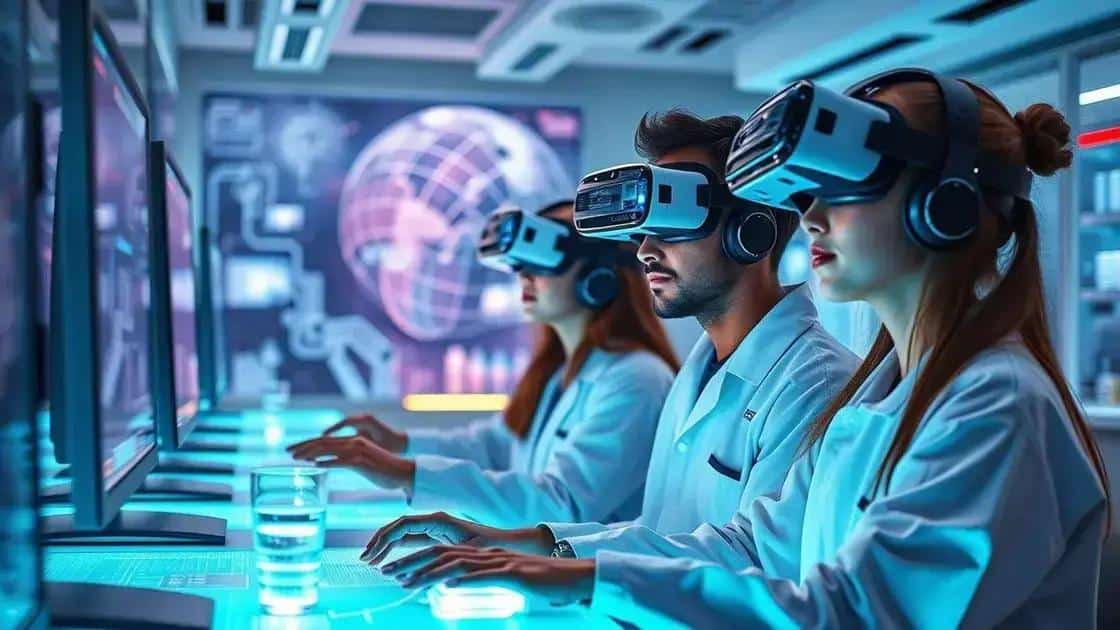
The future trends in virtual lab simulations are exciting and seem to promise even more innovative ways of learning. As technology advances, these simulations will likely become more immersive and effective.
One key trend is the integration of artificial intelligence into virtual labs. AI can personalize learning experiences by assessing student performance and adapting challenges accordingly. This means that each student can receive a customized pathway based on their unique learning pace and style.
Incorporation of Augmented and Virtual Reality
Another trend is the use of augmented reality (AR) and virtual reality (VR). These technologies can help create a fully immersive environment for students. Imagine donning VR headsets to explore a chemical plant or using AR to visualize molecular structures in 3D. Such experiences will make learning even more engaging and tangible.
- Enhanced interaction with the subject matter.
- Real-time data analysis in simulated environments.
- Improved retention of complex concepts.
- New avenues for collaborative learning.
Additionally, cloud technology is expected to play a crucial role. By utilizing the cloud, educational institutions can provide access to extensive resources and simulations without worrying about software installations. Students can access labs from any device, making learning extremely flexible.
Collaborative Simulations
Collaboration tools will likely become a staple in virtual lab environments. Students from different locations will work together in real-time, allowing diverse teams to tackle scientific challenges. Such collaboration can encourage critical thinking and teamwork skills, which are essential in today’s work environment.
As these trends unfold, it’s clear that virtual lab simulations will continue shaping the educational landscape. By leveraging the latest technologies, these labs can enhance student engagement, accessibility, and learning outcomes, preparing the next generation of scientists and innovators.
The future of virtual lab simulations looks promising, with many exciting trends on the horizon. As technology continues to evolve, these simulations will become more immersive and customized for individual learners. The incorporation of artificial intelligence, augmented reality, and cloud technology is set to enhance the learning experience even further. Students will benefit from a safe, engaging, and interactive environment that fosters collaboration and deep understanding of complex topics. By embracing these advancements, educators can prepare students effectively for future scientific challenges.
FAQ – Frequently Asked Questions About Virtual Lab Simulations
What are virtual lab simulations?
Virtual lab simulations are interactive online tools that allow students to conduct experiments and explore scientific concepts in a safe and controlled environment.
How do virtual lab simulations enhance learning?
They provide hands-on experience, immediate feedback, and the ability to manipulate variables, which deepens understanding and retention of complex concepts.
What technologies are being integrated into virtual labs?
Virtual labs are increasingly incorporating artificial intelligence, augmented reality, and cloud computing to create more immersive and personalized learning experiences.
Can students collaborate in virtual lab simulations?
Yes, many virtual lab platforms allow for real-time collaboration, enabling students to work together on experiments and share their findings regardless of their locations.
